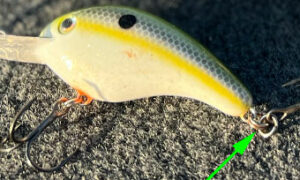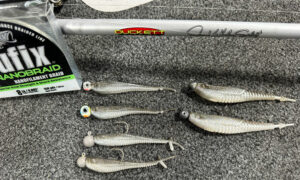
With water temps cooling, many bass-heads tie on topwaters in hopes of catching aggressive schooling fish. But Yamaha pro Todd Faircloth does the opposite, choosing a deep-diving crankbait to target fish that have already moved out.
“It’s a technique I learned years ago fishing local tournaments here on Sam Rayburn Lake where I live,†Todd says. “The same fishermen always caught a lot of bass this time of year, but I didn’t know what they were doing. Gradually, their secret leaked out, and I’ve been using it ever since.â€
Fish the main channel
The secret is concentrating on the far upper reaches of a lake’s main river channel where schools of bass continue feeding actively as they prepare for the colder months ahead. Generally at depths between 10′ and 16′, the fish gather along the edge of the channel….
“A lot of lakes are drawn down to winter pool levels in late October and early November, which pulls both bass and baitfish out of the shallow flats and tributaries where they were in September,†Todd says. “They gather in schools out on the river channel where there’s still plenty of water and where they’ll stay throughout the winter.
“Generally, when the days become consistently cooler and you stop seeing any type of surface feeding activity in the creeks, you can guess the bass have moved out. You can locate them with your electronics, or by fishing.
“I prefer to fish the outside edges of the channel bends, or where a tributary creek actually flows into the main river channel. I’ll keep my boat in deeper water and cast shallow, bringing the crankbait down the steeper edge of the channel. Occasionally, just to give the fish a different look at the lure, I may move shallow and cast deeper, but most of the time the best presentation is retrieving from shallow to deep.â€
Normally, Faircloth fills his reel with 12-lb fluorocarbon to fish 10-16′, but he’ll change to 10-lb line when the bass are a little deeper. He makes long casts, then bounces the crankbait along the bottom during his retrieve, trying to hit any stumps or rocks along the way. This is primarily a structure fishing pattern, but any type of cover usually makes the area more attractive to the fish.
“This is a good time to catch above-average fish in the 4- to 6-lb class, and occasionally a larger one. The schools seem to be filled with bass that size, not a lot of small ones, and when you do catch one, you’re almost always going to catch several more.
“When the school you’re fishing does stop biting, you can run up the river to the next major bend and usually find another school to cast to.â€
“While it lasts, which is usually through November and into December on many lakes, this is one of the easiest and most enjoyable ways to catch bass for anglers during the entire year,†he says. “The fish are still feeding heavily so they’ll readily hit a crankbait, and they’re quality fish too.
Baits
Todd uses Strike King crankbaits. The 5XD and 6XD sizes are good for the 10-16′ range, and the 8XD is a 20′ bait.



























